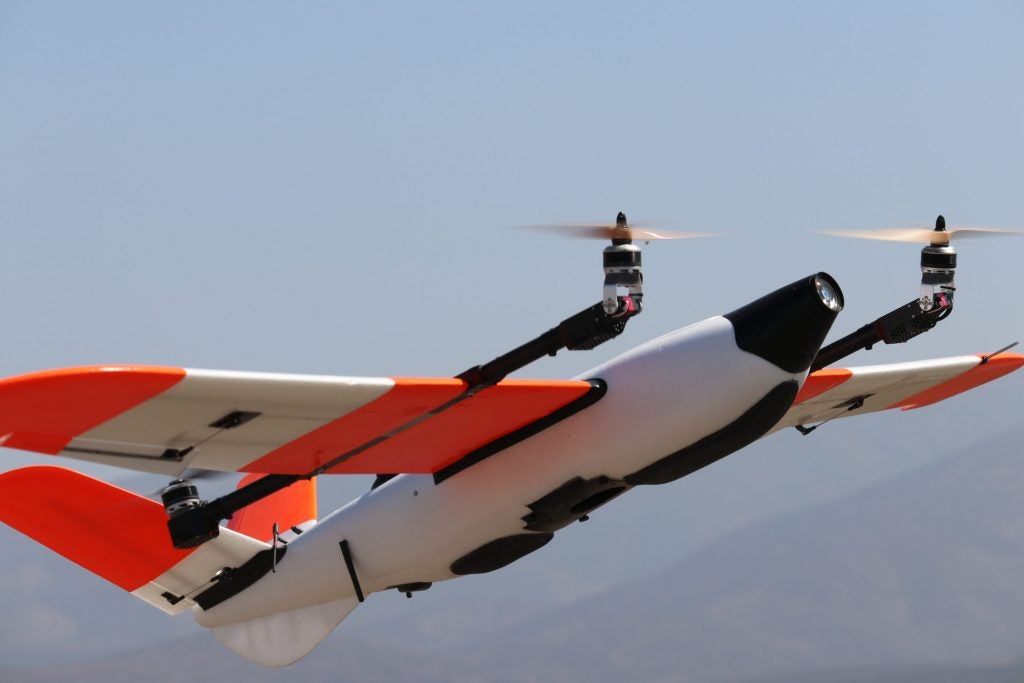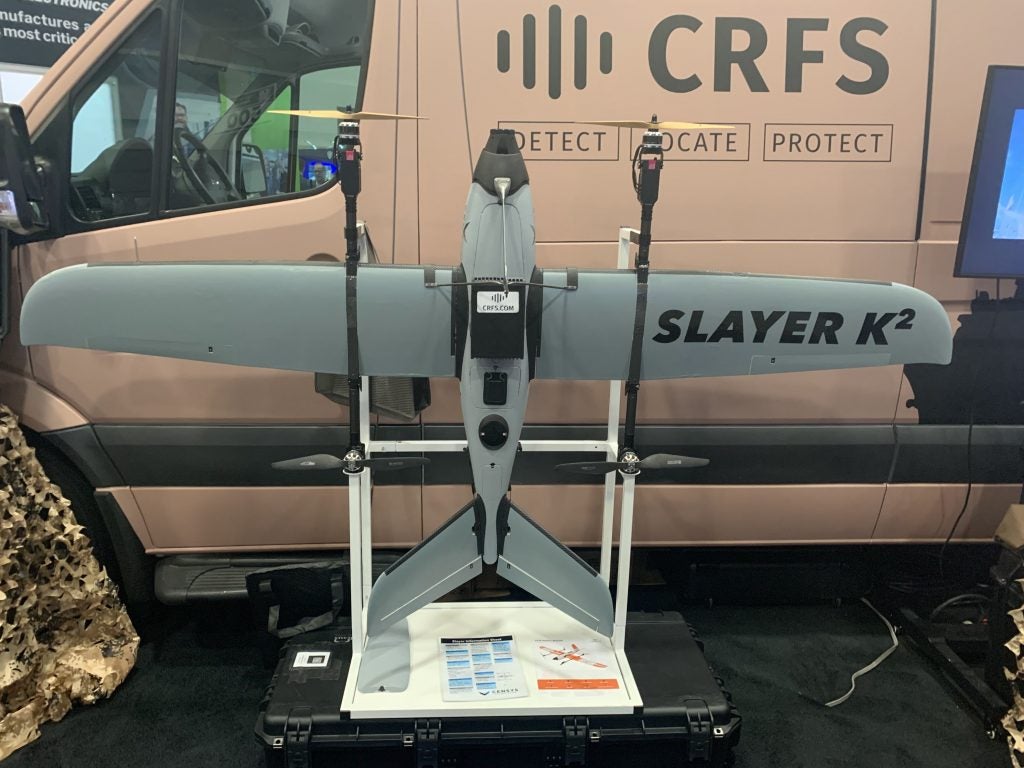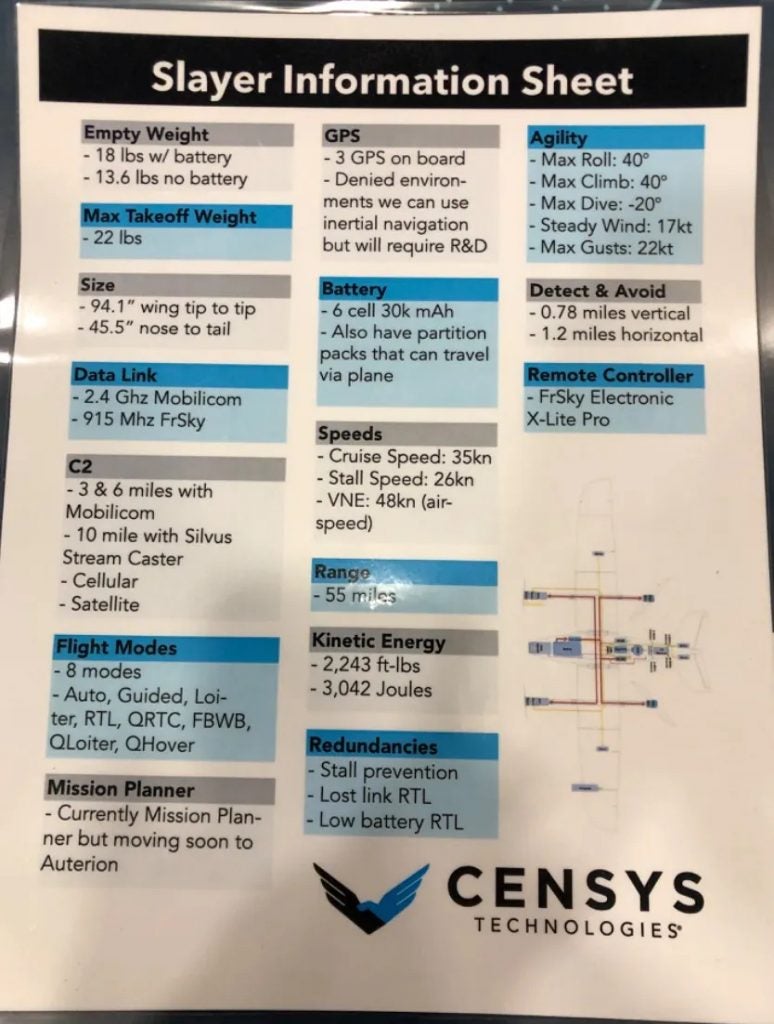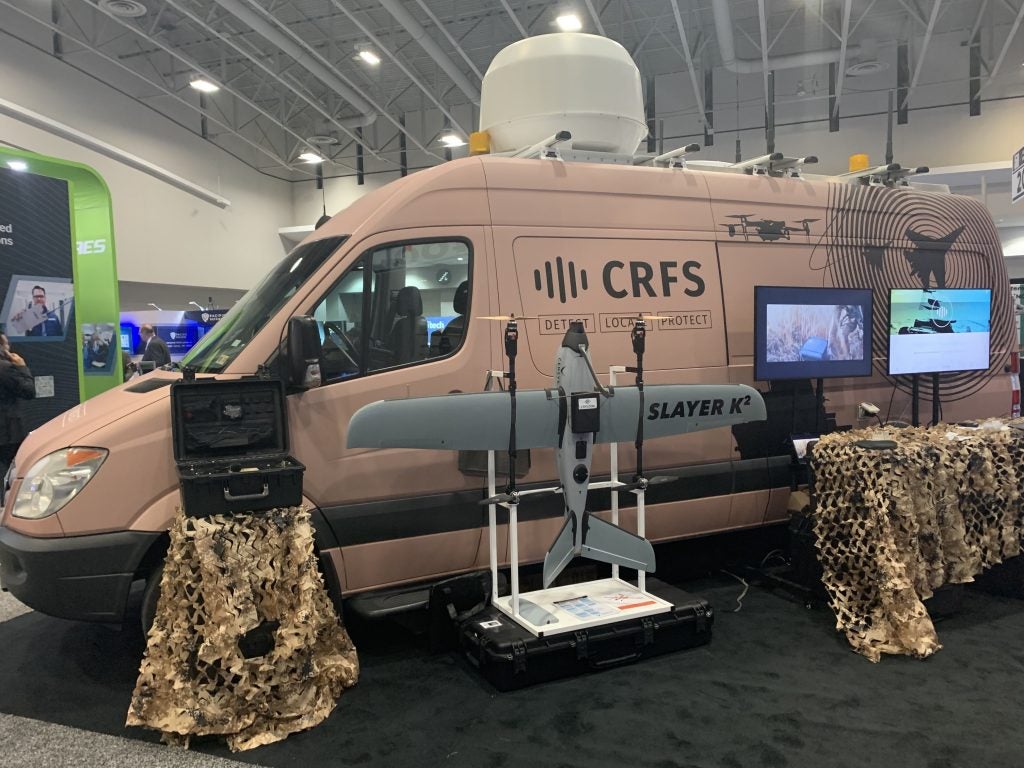AOC 2022: Censys Technologies Debut Slayer Kinetic Killer C-UAS Drone
Censys Technologies debuted the Slayer Kinetic Killer at the 59th Annual Association of Old Crows International Symposium and Convention. Slayer K2 was one of many Counter-Unmanned Aerial Systems (C-UAS) systems at AOC. However, what sets Slayer K2 apart is its unique approach to C-UAS the system takes. Overt Defense was able to speak with Censys Technologies Vice President of Quality and Safety Duke Samouce on the company’s new C-UAS system.

Slayer K2 is a C-UAS development based on Censys Technologies’ existing Sentaero BVLOS. The company’s civilian UAS becomes a loitering C-UAS drone, with the system intercepting threats by crashing into them. Duke touched on the origins of the concept.
“Censys Technologies has been in business for about five years now. In the past two years, we’ve developed what’s called Sentaero Beyond Visual Line of Sight (BVLOS). We use it a lot for utilities, long linear inspections of power lines, gas, oil, agriculture, mapping and search and rescue. We’ve have 12 different payloads that you can go into the aircraft and are swappable in the field, and one of them is a gimbal that has infrared and day optics. It can zoom in both EO and IR. So from those capabilities I’ve developed an aircraft pointing towards DoD (Department of Defense).”
Censys Technologies aims to use Sentaero BLVLOS’ State-of-the-Art Detect-and-Avoid System, which allows the drone to automatically avoid other aircraft, to detect and track UAS threats.
“We look for what the threat drones’ signature be it optical or IR. Once it picks it up, it’s actually very simple. It keeps it in the middle of the field of view (referring to the Slayer K2’s sensor) and keeps it in the middle or the FOV until it’s impacted. If it moves out of the center of FOV, SK2 just maneuvers to return it to the center.”
If Slayer K2 fails to intercept the first time, the drone can attempt to intercept the threat again.
“We may not get it the first time. I would like to think our percent kill would be 100% the first time but we’ll just retarget until we get it.”

Once detected and tracked, Slayer K2 will intercept by physically ramming the threat. Modifications to the Sentaero BVLOS for this mission include reinforcements to the airframe and a mounted blade.
“This is a counter UAS capability, reinforced leading edges, and vertical strike device. This aircraft with no explosives, flying at 50 knots and weighing 22 pounds has the kinetic energy of a 2245-pound impact. So we can take out very large drones.”
If the threat was intercepted and there were remaining Slayer K2s, the drones could be recovered for future use.
“SK2 can return to launch. If you launch more than one, and the first one takes the threat out with no more threats remaining, we’re not going to sacrifice the second SK2. You can give it a signal to come back and it’ll go back into its vertical rest and land. And that’s what these [Sentaero BVLOS] do. If you lose signal, they come back and land by themselves. If you get low on battery, they come back and land by themselves. It’s all very much autonomous.”
Duke noted the application of what Censys’ Slayer K2 would have, highlighting its role in a layered C-UAS network as the system could deal with UAS threats that other C-UAS defenses would struggle with.
“Counter UAS has to be a layered defense because you’ve have other capabilities here that might shoot nets, quadcopters might fly up and hit it, behind me they have an RF (radio frequency) transmitter that knocks them out. If the threat has RF for guidance. If the threat UAS is just using GPS for guidance RF jamming is not going to stop them. Unless you actually hit it, it’s not going to stop that drone. If it’s going to a grid point with 20 pounds of explosive on it, it’s going to get there. But a kinetic killer can take it out.”

The range that Slayer K2 brings to a network was highlighted too. With the drone being able to intercept at considerable distances, preventing potential collateral to the asset the system is protecting.
“Imagine your securing a nuclear power plant or any other critical infrastructure. You don’t want threat UAS’s to get so close, because you can have an explosion close to the plant. You want Slayers in their boxes North, East, South, and West of what is being protected. Wherever it’s (UAS) coming from. You want to launch from the closest SLAYER K2 pods to meet it 23+ miles out and take it out.”
When asked which categories of UAS Slayer K2 could take on, Duke stated that the system could deal with UAS threats up to Group 3.
“I would think up to a Tier 3 (Group 3) depending on how it hits it. So one, no problem. Two, no problem. Three, I believe the Iranian ones, with that amount of 3000 joules or 2245 foot-pounds of impact is gonna take out a Tier 3.”
Duke further elaborated on Slayer K2’s capabilities, referring to the Iranian HESA Shahed 136 loitering munitions currently being used in Ukraine as an example.
“The Iranian drones that are being used in Ukraine, this runs into it, it’ll take it out, runs in the back of it and it will take it out because it’ll take out the propeller. So it’s very effective.”
However, the speed of Slayer K2 at this iteration is not enough to catch up to drones like the Shahed. With Group 3 UAS threats going up to twice the speed of Slayer K2, Duke acknowledged that speed will be an issue. Censys Technologies is also working on a faster drone that will “bridge this (speed) performance gap.”
When asked about how lessons from Ukraine are influencing Slayer K2’s design, Duke highlighted the challenges of a GPS-denied environment and the use of the UAS for Intelligence, Surveillance, and Reconnaissance in addition to its C-UAS mission.
“Right now it’s the GPS-denied environment, alright. Because the Russians are jamming the crap out of everything over there. We (also) want to be able to operate SLAYER as an ISR (SLAYER ISR) element so that Ukrainians can use it to find where the Russians are, and they can return and use it over and over again.”

This was Slayer K2’s first appearance, with the drone on display being the first prototype and, subsequently, the system is still in the early stages of development. Information provided by Censys Technologies indicates that the drone’s mission planner and ability to operate in GPS-denied environments require further research and development. Duke also noted that Slayer K2 will remove components from the Sentaero BVLOS, as for C-UAS the drone will not need as many components compared to the civilian design.
“We’ve got a lot of interest. We’re gonna be going to a demonstration soon. This is the first time it’s ever been brought out. So we’ll build another one. Because the one-time use will have different aspects about it. It won’t have as many electronics and it may not even be painted.”
The ongoing Russian Invasion of Ukraine has peaked or at least enhanced, focus on C-UAS systems. At AOC 2022, many more C-UAS systems from microwaves, lasers, and jammers were on display compared to last year’s event.

